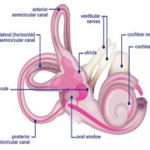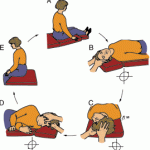Benign Paroxysmal Positional Vertigo (BPPV) is a non-life-threatening condition of the vestibular system, the organ of balance and equilibrium.
BPPV is characterised by dizziness, vertigo, loss of balance and sometimes nausea. These effects often appear unexpected and for no obvious reason. They are bought on by innocuous, everyday movements of the head.
Fortunately, the mechanism that causes these symptoms is well understood, and the solution is simple.
To understand what is happening in BPPV, we have to look at anatomy. 
The vestibular system, the organ of balance and equilibrium, sits in the middle ear alongside the structures of hearing.
It consists of three main components: Utricle, Saccule, and Semicircular Canals. (The latter have expanded the termini to include Ampullae.)
Within the Utricle, Saccule, and Ampullae are cells called hair cells with tiny hairs attached.
In the Uterus and Saccule, these cells sit in a jellylike substance whose surface is covered in small calcium structures called Otoliths.
Each hair cell is innervated by nerve fibres, branches of the vestibular nerve, which relay information about balance and equilibrium to the brain. The Utricle, Saccule, Semi-circular canals and Ampullae are all full of fluid.
When the head moves, so does the fluid. This fluid movement bends the hairs on the hair cells, relaying a nerve impulse to the brain.
In normal circumstances, this sequence of events is only initiated by the movement of the head.
In the case of BPPV, a stray Otolith causes it. A dislodged Otolith can make its way out of the Utricle or Saccule and into one of the Semi-Circular Canals. Here, it increases the fluid’s momentum, causing feelings of dizziness, vertigo, and loss of balance.
Fortunately, this is not a serious condition, and the solution is fairly straightforward. 
It involves moving the head through a set of prescribed movements to encourage the Otolith back into the utricle or saccule.
The movements are gentle, measured, and safe. They may bring on dizziness, but this is part of the process.
They vary depending on which semi-circular canal the Otolith is sitting in.
The Epley Manoeuvres return the Otolith from the Posterior Semicircular Canal. They are the most well-known and effective treatment for the most common form of BPPV, Posterior Canal BPPV. Others include the Gufoni and Deep Head Hanging manoeuvres.
For treating BPPV, we recommend that you consult a highly skilled and experienced physical therapist with a refined understanding of anatomy and physiology.
December 7th 2022
Yoga as a Holistic Approach for Your Health amp Wellbeing written by Rosemary Kemp The physical aspect of yoga which we have come to know as the different postures doesn t just target the body It is also a workout for the mind and the spirit This makes yoga a...
READ MOREDecember 7th 2022
In a situation of a sudden musculoskeletal injury the body has several ways of dealing with the new imposed stress The physiological processes of healing are quite complex but we can generally describe them in three stages strong Inflammation Repair and Remodeling strong In this article we outline the core...
READ MOREDecember 7th 2022
p When walking into our span style text-decoration underline span style color ff text-decoration underline a style color ff text-decoration underline href https stjames nordicbalance co uk gym-membership target blank rel noopener gym in St James's a span span you will find that like most gyms there is a weights...
READ MORE